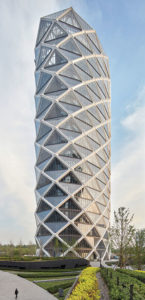Form Inspires Structure in Beijing
Skidmore, Owings & Merrill LLP was an Award Winner for its Poly International Plaza project in the 2016 NCSEA Annual Excellence in Structural Engineering Awards Program in the Category – New Buildings over $100M.
The elliptically shaped faceted exterior of the 530-foot (161.2-meters) tall Poly International Plaza iconic tower in Beijing was inspired by Chinese paper lanterns to shimmer as it reflects the sky. It is the first structure of its kind, incorporating a four-story super diagrid frame module without perimeter columns and designed to remain essentially elastic in a region of high seismicity. As a non-prescriptive structural system, careful attention was paid to the behavior of the structure, and enhanced analysis and design objectives were set and met.
Structural Efficiency
The diagrid module, four stories tall and 60 feet (18 meters) across between nodes, was fabricated using concrete filled steel tubes that work with a central reinforced concrete core to resist gravity and lateral loads. With nodes occurring every two floors, intermediate levels were suspended from nodal levels above to avoid loading diagrid members in bending between nodes, thus increasing the efficiency of the structure. This integrated system architecturally allows for a natural double exterior curtain wall system to accommodate the extreme climate of Beijing.
Helical Load Paths
By virtue of the diagrid system, lateral loads are transmitted to the base along helical load paths, not relying on a continuous diaphragm slab at the building ends. The exoskeletal diagrid system on the perimeter acts in tandem with the concrete walls at the building core to provide a dual gravity and lateral load resisting system with multiple continuous and redundant load paths. Also, global buckling stability afforded by the three-dimensional form of the diagrid makes it possible to introduce large, architecturally exciting atria into the ends of the plan.
Buckling Analysis
Extensive buckling analyses were performed to confirm that the diagrid members would yield before local or global buckling occurs. To ensure the stability of the diagrid at the atria, even if the surrounding slabs crack in a major seismic event, in-plane steel floor bracing was introduced to act as a substitute for the diaphragm slabs and stabilize the diagrid.
Hoop Stresses
Significant tensile hoop and radial forces in the diaphragms and floor framing were noted at mid- level floors, resulting from the tendency for the diagrid frame to bulge under gravity loads. These forces are resisted by the perimeter steel framing members at nodal levels and radial steel floor framing members that connect the diagrid nodes to the inner concrete core, as well as by additional diaphragm slab reinforcement.
Non-linear Analysis
Extensive non-linear pushover and response history analyses were undertaken, using Perform-3D, in the two principal directions which included material and geometric non-linearity (P-Delta effects) and strength degradation effects. The analyses indicated that shear wall link beams yield first, followed by yielding of some diagrid members at the base. Shear walls take relatively low shears, with no yielding in the rebar at the boundary zones of the walls. The non-linear analyses confirmed that the global structure is life-safe in a rare earthquake event.
Redundancy and Progressive Collapse
The hangers supporting the intermediate floors were extended down to the nodal floors below without contact and with vertical slip joints at the bases, ensuring that they do not load on the floors below. In the event of a localized hanger failure, the hanger extension member would drop and come into contact with the floor structure below, transferring the loads. Selected diagrid members with high axial forces under gravity load were removed and progressive collapse analysis performed to ensure that a global progressive failure of the perimeter diagrid frame would not occur.
Diagrid Node
The integrity of the diagrid structural system relies on the performance of the welded nodes. The diagrid nodes were modularized and consist of two horizontal steel plates in line with the perimeter beam flanges, one vertical steel plate centered on the node work-point, and vertical curved plates between the horizontal flange plates aligned with the diagrid sections above and below. Finite element analyses were performed for representative diagrid nodes. Reduced scale tests (cyclic and monotonic tests) were conducted at the China Academy of Building Research (CABR) in Beijing. The tests confirmed the importance of providing concrete within the nodes to ensure that eventual failure occurs beyond the nodes, and to reaffirm the adequacy of the node design.
Conclusion
This landmark tower leverages a pure diagrid structural system to introduce full height atria and other shared interior spaces, and create unique, light-filled areas. The project, now complete, stands as a visible icon in the new district’s skyline.▪

